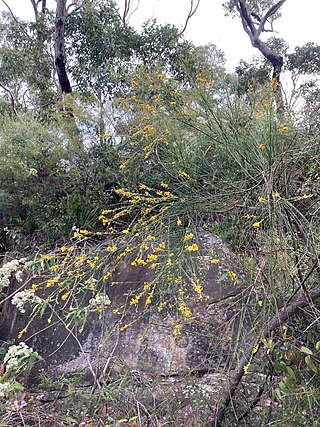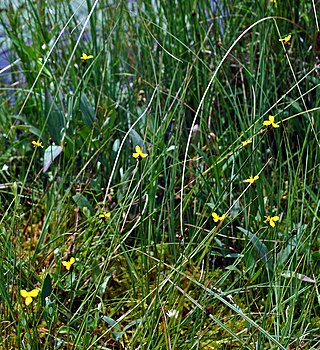
Crotalaria is a genus of flowering plants in the family Fabaceae commonly known as rattlepods. The genus includes over 700 species of herbaceous plants and shrubs. Africa is the continent with the majority of Crotalaria species, which are mainly found in damp grassland, especially in floodplains, depressions and along edges of swamps and rivers, but also in deciduous bush land, roadsides and fields. Some species of Crotalaria are grown as ornamentals. The common name rattlepod or rattlebox is derived from the fact that the seeds become loose in the pod as they mature, and rattle when the pod is shaken. The name derives from the Ancient Greek κρόταλον, meaning "castanet", and is the same root as the name for the rattlesnakes (Crotalus).

The Xyridaceae are a family of flowering plants. This family has been recognized by many taxonomists and is known as the yellow-eyed grass family.

Viminaria juncea is the single species in the genus Viminaria endemic to Australia. The genus is in the pea family Fabaceae. It is colloquially known as native broom after its resemblance to the related European broom plants. The Noongar peoples know the plant as koweda.

Brassica juncea, commonly brown mustard, Chinese mustard, Indian mustard, leaf mustard, Oriental mustard and vegetable mustard, is a species of mustard plant.

Xyris is a genus of flowering plants, the yelloweyed grasses, in the yellow-eyed-grass family. The genus counts over 250 species, widespread over much of the world, with the center of distribution in the Guianas.

Chondrilla juncea is a species of flowering plant in the family Asteraceae known by a number of common names, including rush skeletonweed, gum succory, devil's grass, and nakedweed. The plant is native to Europe, Asia, and North Africa, but it is known throughout most temperate regions of the world as an introduced species which is usually considered a noxious weed.

Xyris complanata, known as the feathered yellow-eye is a tufted herb in the Xyridaceae family. It is native to southern China, India, Sri Lanka, Thailand, Cambodia, Laos, Vietnam, Malaysia, Indonesia, the Philippines, New Guinea and Australia. It is also naturalized in Hawaii where it is known as Hawai'i yelloweyed grass. In New South Wales it grows in moist areas, often near swamps or in heathland.

Xyris montana, the northern yelloweyed grass, is a North American species of flowering plants in the yellow-eyed-grass family. It grows in eastern and central Canada and in the northeastern and north-central United States.

Machaerina juncea, commonly known as bare twig-rush or tussock swamp twig rush, is a sedge in the sedge family, Cyperaceae, that is native to Australia, New Zealand, and New Caledonia.
Lake Hawdon South Conservation Park is a protected area located in the Australian state of South Australia in the locality of Bray about 280 kilometres (170 mi) south-east of the state capital of Adelaide and about 18 kilometres (11 mi) east of the town of Robe.

Boronia juncea is a plant in the citrus family, Rutaceae and is endemic to the far south-west of Western Australia. It is an erect shrub with linear, short-lived leaves and groups of up to eight white to pink, four-petalled flowers.

Xyris lacera, is a yellow-eye found in the southern parts of Western Australia, in swampy areas. It is a tufted perennial herb, growing from 0.2 to 1.5 metres tall. This is one of the many plants first published by Robert Brown, appearing in his Prodromus Florae Novae Hollandiae et Insulae Van Diemen in 1810.

Xyris gracilis, commonly known as slender yellow-eye, is a species of flowering plant in the family Xyridaceae and is endemic to eastern Australia. It is a tufted herb with linear leaves with 5 to 8 flowering stems with bright yellow flowers.

Xyris operculata, the tall yellow-eye, is a flowering plant species endemic to south eastern Australia. Seen in swampy areas, often in heathland. A tufted herb, growing up to 1 metre high. This is one of the many plants first published by Jacques Labillardière, appearing in his Novae Hollandiae Plantarum Specimen in 1805. The specific epithet operculata is derived from Latin. Referring to the hardened tip of the fruiting capsule, which does not divide when the capsule splits, and may be seen being cast aside like a lid.

Xyris bracteata is a yellow-eye which grows in dry or wet heath, or in open eucalyptus woodland with a heath understorey. Only found in eastern New South Wales, Australia, it is a robust erect herb, growing up to 60 cm high. This is one of the many plants first published by Robert Brown, with the type known as "(J.) v.v.", appearing in his Prodromus Florae Novae Hollandiae et Insulae Van Diemen in 1810. The specific epithet bracteata is derived from Latin, meaning "having bracts."

Xyris marginata, commonly known as alpine yellow eye, is a monocot in the family Xyridaceae which is endemic to King Island (Tasmania) and Tasmania, commonly growing in button grass moorlands, at altitudes of up to 1070 meters (3,510.5 ft) above sea level. It was first collected by German-Australian botanist Ferdinand von Mueller in 1875.
Patersonia juncea, commonly known as rush leaved patersonia, is a species of plant in the iris family Iridaceae and is endemic to a restricted part of the south-west of Western Australia. It is a tufted perennial herb with linear leaves and pale violet tepals.
Lechenaultia juncea, commonly known as reed-like leschenaultia, is a species of flowering plant in the family Goodeniaceae and is endemic to the south-west of Western Australia. It is an erect, perennial herb or shrub with crowded, fleshy leaves, and pale blue flowers.

Lechenaultia juncea, commonly known as scarlet leschenaultia, is a species of flowering plant in the family Goodeniaceae and is endemic to the south-west of Western Australia. It is an open, ascending shrub with narrow, crowded, rather fleshy leaves, and scarlet to orange-red flowers.

Conostylis juncea is a rhizomatous, tufted perennial, grass-like plant or herb in the family Haemodoraceae, and is endemic to the south-west of Western Australia. It has cylindrical or flat leaves and yellow flowers on a short flowering stem.















